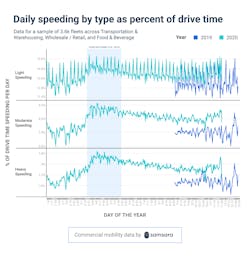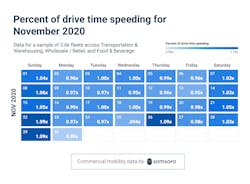The pressure to deliver more goods this holiday season has caused a rise in speeding, according to commercial fleet data from by telematics provider Samsara.
On Thanksgiving Day alone, speeding was up 9% over the 2020 annual average, versus being 4% above annual average in 2019. If Christmas Day speeding follows the similar doubling trend, that number will increase to 30%.
“Speeding tends to spike on holidays, and we predict it will spike again this Christmas,” wrote Ali Akhtar, Samsara director of data science in a summary of the findings. “Our data shows that the days most prone to speeding are the holidays themselves, likely due to emptier roads.”
Roads are less congested with fewer commuters and travelers as COVID-19 still remains a threat. That has led to a need for more delivery trucks. E-commerce is up 25 to 35% year over year, according to Deloitte.
Meanwhile, Samsara revealed miles driven by its sample size of 3,676 commercial fleets increased 10% year over year, while vehicle utilization is up 5%. These fleets were located in the food and beverage, transportation, and warehousing segments, comprising 110 million trips completed by 80,000 vehicles.
An earlier Samsara report indicated the springtime COVID-19 shutdowns that cleared highways led to a 20% rise in heavy and severe speeding, or >11 mph over the legal limit. This past fall, heavy and severe speeding was up 18% year over year.
Speeding also occurred more frequently over weekends.
The National Highway Traffic Safety Administration found speeding was a contributing cause of about one in every four fatal crashes in 2017. This recent data can be used to encourage drivers to be more safe this holiday season.
“We believe the best way to effectively serve our customers is to intimately understand their logistics needs and be able to flex our services around their supply chain disruptions,” said Seth Runser, vice president of Linehaul Operations for ABF Freight. “We have been able to do this thanks to investments in technology that provide a more actionable view of our customers’ specific requirements and pain points, and they have allowed us to continue to provide these services as safely as possible."
About the Author
FleetOwner Staff
Our Editorial Team
Kevin Jones, Editorial Director, Commercial Vehicle Group
Josh Fisher, Editor-in-Chief
Jade Brasher, Senior Editor
Jeremy Wolfe, Editor
Jenna Hume, Digital Editor
Eric Van Egeren, Art Director


